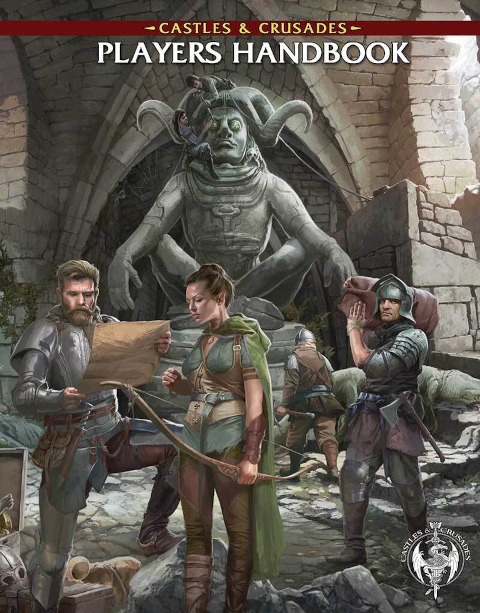
last updated 2022-05-07 (for 8th printing of C&C) PDF version
Contact me (cenbe at protonmail dot com) if you're interested in playing in a long-running campaign (Milwaukee, Lower East Side).

Please bring dice to the game rather than using a computer to simulate dice rolls. As the great mathematician John von Neumann said, "Anyone who considers arithmetical methods of producing random digits is, of course, in a state of sin." Unless, of course, you have a Dragonbone...
No assassins or paladins. These classes are at the two extremes of alignment, and always cause problems. For the paladin fanboys, there is a Knight class.
Sorry, no illusionists; I find them too hard to referee. If you're good at playing this class of character and have clear ideas about how you would expect it to be handled, we can talk. EDIT: Actually, my thinking is changing on this: a referee doesn't have to say no to illusionists; just tell them that the ancient red dragon they were trying to conjure at first level actually looks more like a balloon animal. And remember, in Castles & Crusades, illusionists get healing spells...
Because of the rich set of classes in Castles & Crusades, even with these restrictions, and bearing in mind the typical classes suggested for each race, you still have 48 race and class combinations to choose from.
Multi-classing is an optional rule in Castles & Crusades which we will not be using.
Rolling up the character:
Called shots will not be used except where specified in the monster description (e.g. the hydra). This means, for example, that equipping a character with a helmet will not affect his armor class; it's purely a fashion accessory.
Critical hit (natural 20): always hits for max damage. Fumble (natural 1): always misses, lose the next round's action.
Initiative is rolled each round: once for the characters, and once for their opponents (d10, higher is better).
Spellcasters casting during mêlée are not subject to spell failure if they are hit before their initiative.
Note the way spells are timed: "A spell that takes one round (CT 1)
to cast comes into effect during the caster’s initiative turn for that
round... spells that take more than one round to cast come into effect
during the caster’s initiative turn on the last round of the casting
time for the spell." (PHB p.74)
Druid's totem shape: The druid regains 1d4 hit points both on changing to the totem shape and on changing back again. If they have more than one totem shape, they can change directly from one to the other without returning to their original form first.
| Firing missiles into mêlée: no restrictions if you have line of sight. However, if there's another target blocking your opponent, there's a d6 chance of having to make the hit roll on the secondary target instead, based on their relative sizes. Roll d6 before the hit roll: |
|
Flaming oil: the attacker must hit an AC of 10 + DEX bonus. Damage is 1d8 the first round and 1d4 for two rounds thereafter if not extinguished. On a miss, if the oil hits a floor or wall, it bursts into flame, doing 1d6 damage to any person or monster within 10 feet.
Grappling: We will not be using the grappling/pummeling/overbearing rules in the PHB. To make a grappling attack:
| defender | ||||
| S | M | L | ||
| S | 3 | 4 | 5 | |
| attackers | M | 2 | 3 | 4 |
| L | 1 | 2 | 3 | |
Two Weapon Fighting: A character attempting this difficult feat is normally at -3 to hit for the primary hand and -6 for the off hand, and STR bonus is not added to the hit roll (PHB p.177). The character's DEX bonus can reduce these penalties: for example with a DEX of 18 (bonus +3) the to-hit rolls would be d20 + BtH + 0 for the primary hand and d20 + BtH - 3 for the off hand. Two weapon fighting is only allowed with mêlée weapons.
Dispel Magic: This spell has one of the following three results, as selected by the caster:
For the first result, the caster must make an intelligence check for each possible spell or effect. If a location is selected, only spells cast on that specific location are affected.
Levitate: a levitating character may cast spells freely, but any action involving exertion (especially combat, but not e.g. picking a lock) will prove difficult due to inertia. Attacks are at -4 and other actions require a dexterity check at CL 4.
Light: this spell may not be cast on a creature's eyes to blind it. As the spell notes, only objects may be the target.
Spiritual Weapon: the cleric must concentrate to direct the weapon, i.e. they may not attack at the same time the spell is in effect. The cleric must maintain line of sight to the weapon. If it goes out of range, the spell ends. However, if something intervenes (e.g. an illusory wall, a large creature), the cleric may cause the weapon to appear in a new location as long as the spell has not expired.
Wall of Wind: the wall is 10' long per caster level.
Web: Anyone trying to pass through a webbed area who is not already caught in it must make a dexterity check every 10' to avoid suffering the spell's effects.